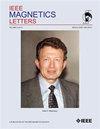Effects of Ta Buffer Layer on Structural and Magnetic Properties of Sputtered Ni2FeAl
IF 1.1
4区 物理与天体物理
Q4 ENGINEERING, ELECTRICAL & ELECTRONIC
引用次数: 0
Abstract
In the present investigation, we report the growth of off-stoichiometric Ni-based Heusler thin films of different thicknesses (6–30 nm) on a Si (100) substrate by radio frequency sputtering at 300 °C. We have used an indigenously prepared target comprising thin sheets of Ni, Fe, and Al in specific proportions. Of all the Heusler alloys, Ni2FeAl is the least researched alloy that may offer immense possibilities in developing spin-based devices. The Ni55Fe14Al31 films crystallize into the A2 phase as confirmed by the diffraction pattern. With the increase in the thickness of films, surface roughness improves followed by an increase in saturation magnetization (Ta缓冲层对溅射Ni2FeAl结构和磁性能的影响
在本研究中,我们报告了在300°C的射频溅射下,在Si(100)衬底上生长不同厚度(6-30 nm)的非化学测量ni基Heusler薄膜。我们使用了一种由特定比例的Ni, Fe和Al薄片组成的本土制备的靶。在所有Heusler合金中,Ni2FeAl是研究最少的合金,它可能为开发基于自旋的器件提供巨大的可能性。衍射图证实,Ni55Fe14Al31薄膜结晶为A2相。随着膜厚的增加,表面粗糙度增大,饱和磁化强度增大。此外,我们还探讨了Ta缓冲剂对薄膜静态和动态磁性行为的影响,并将其与未缓冲的薄膜进行了比较。Ta缓冲层对薄膜的表面形貌有显著影响。面内磁滞回线显示有Ta缓冲的磁滞回线具有较高的磁滞回线质谱。通过铁磁共振技术在宽带微波频率上探测了动态磁化强度,并用吉尔伯特阻尼常数(α)进行了量化。在30nm厚的薄膜中,Ta缓冲液将Gilbert阻尼常数从10.1 × 10−3降低到8.4 × 10−3。
本文章由计算机程序翻译,如有差异,请以英文原文为准。
求助全文
约1分钟内获得全文
求助全文
来源期刊

IEEE Magnetics Letters
PHYSICS, APPLIED-
CiteScore
2.40
自引率
0.00%
发文量
37
期刊介绍:
IEEE Magnetics Letters is a peer-reviewed, archival journal covering the physics and engineering of magnetism, magnetic materials, applied magnetics, design and application of magnetic devices, bio-magnetics, magneto-electronics, and spin electronics. IEEE Magnetics Letters publishes short, scholarly articles of substantial current interest.
IEEE Magnetics Letters is a hybrid Open Access (OA) journal. For a fee, authors have the option making their articles freely available to all, including non-subscribers. OA articles are identified as Open Access.
 求助内容:
求助内容: 应助结果提醒方式:
应助结果提醒方式:


